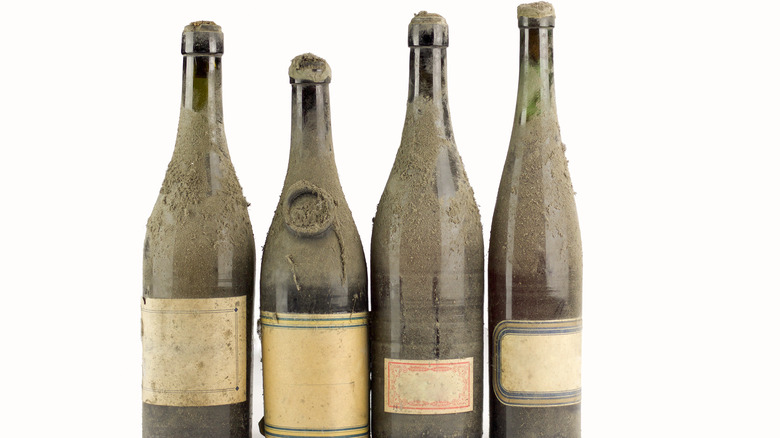One Of The Oldest Bottles Of Wine Could Date Back To 325 CE
Despite what we see in Hollywood, youth isn't always king. There are a lot of things that get better with age, like your favorite pair of jeans, a great leather handbag, and your perspective on life. In the food and drink realm, cheese, whiskey, and, of course, wine are among the treats that benefit from spending time unbothered before being enjoyed. And older bottles of wine can sell for unbelievably high prices. Hardcore collectors are more than willing to shell out big cash to get their hands on prized bottles.
For instance, a 1869 vintage of Bordeaux wine from Chateau Lafite Rothschild once sold for $230,000 in an auction (via Vin-X). In the case of a 1787 Chateau Margaux previously owned by Thomas Jefferson, the bottle was accidentally broken by a waiter and the insurance company had to pay out $225,000 for it. And in 1997, 2,000 bottles of 1907 Heidsieck Champagne were uncovered in a shipwreck from World War I. Among those, one single bottle in pristine condition sold for a whopping $275,000. As old and rare as these wines were, they have nothing on an ancient bottle of wine that can be found at a German museum.
Aged wine, indeed
A few years before that 1869 bottle of Rothschild was produced, archaeologists unearthed the tomb of an ancient Roman nobleman and noblewoman in what is now Speyer, Germany, per The Drinks Business. There were various broken and empty wine bottles in the grave, but one single magnum-sized bottle remained completely intact with its contents preserved inside (via Gastro Obscura). It was later discovered that the wine had been expertly prepared to stand the test of time — with a generous amount of olive oil poured into the bottle to prevent evaporation and a wax seal. The most astonishing discovery was that the tomb was estimated to have been there since 325 CE, making the bottle almost 1,700 years old — hence, the oldest unopened wine in the world.
Today, the wine is famously known as Römerwein aus Speyer and sits in Germany's Historical Museum of the Palatinate. It hardly resembles wine anymore; the bottle contains a murky liquid and solid mass. Surprisingly, experts say that, because of its pristine preservation, the wine could probably be safely consumed but is highly unlikely to be actual "wine" anymore, as the alcohol is undoubtedly gone. Not to mention, it would taste awful.
While researchers and historians would love to get their hands on the liquid inside to research it, the museum says no way, not daring to even open the bottle. After all, who wants a potential repeat of that Chateau Margaux bottle disaster?

